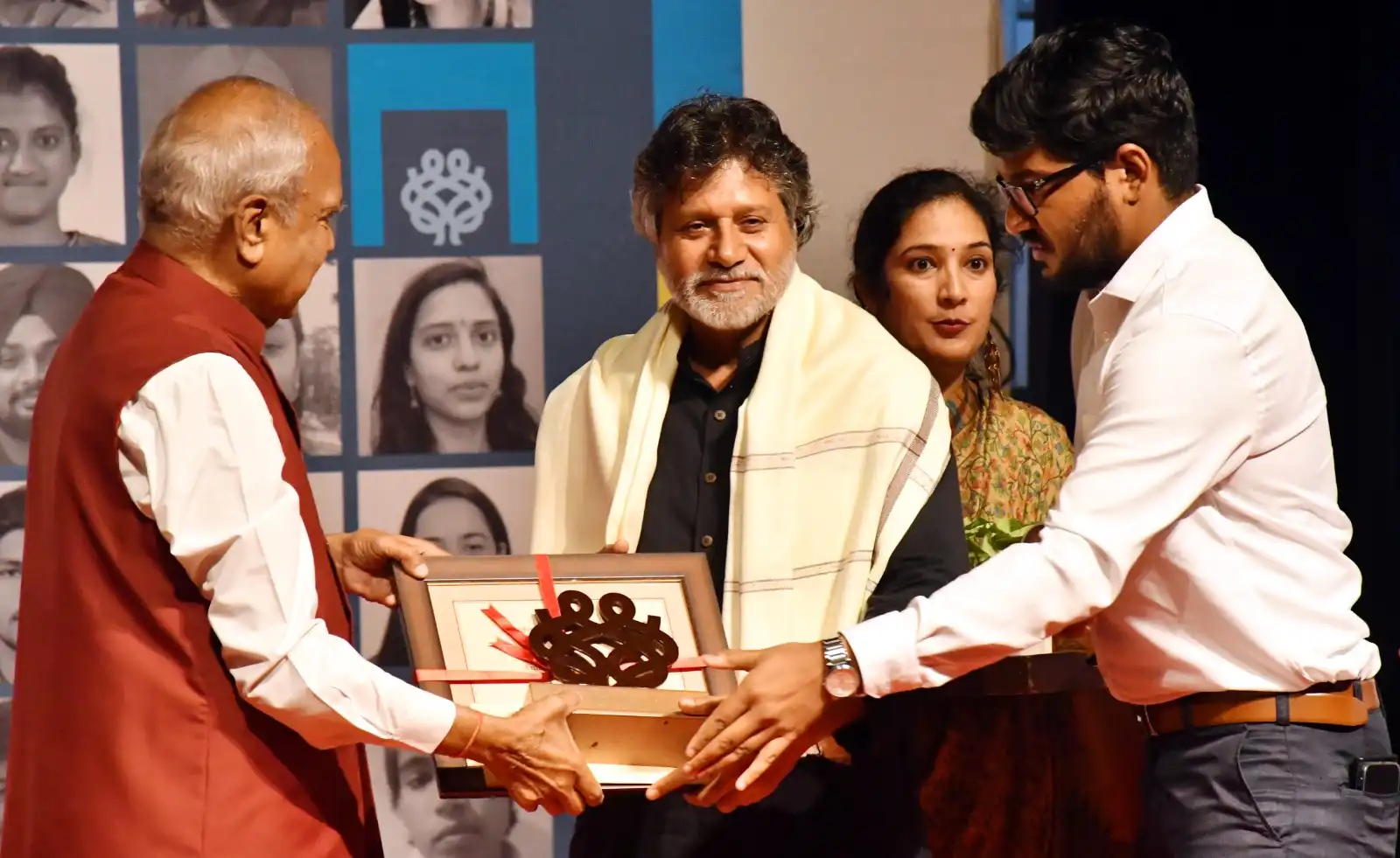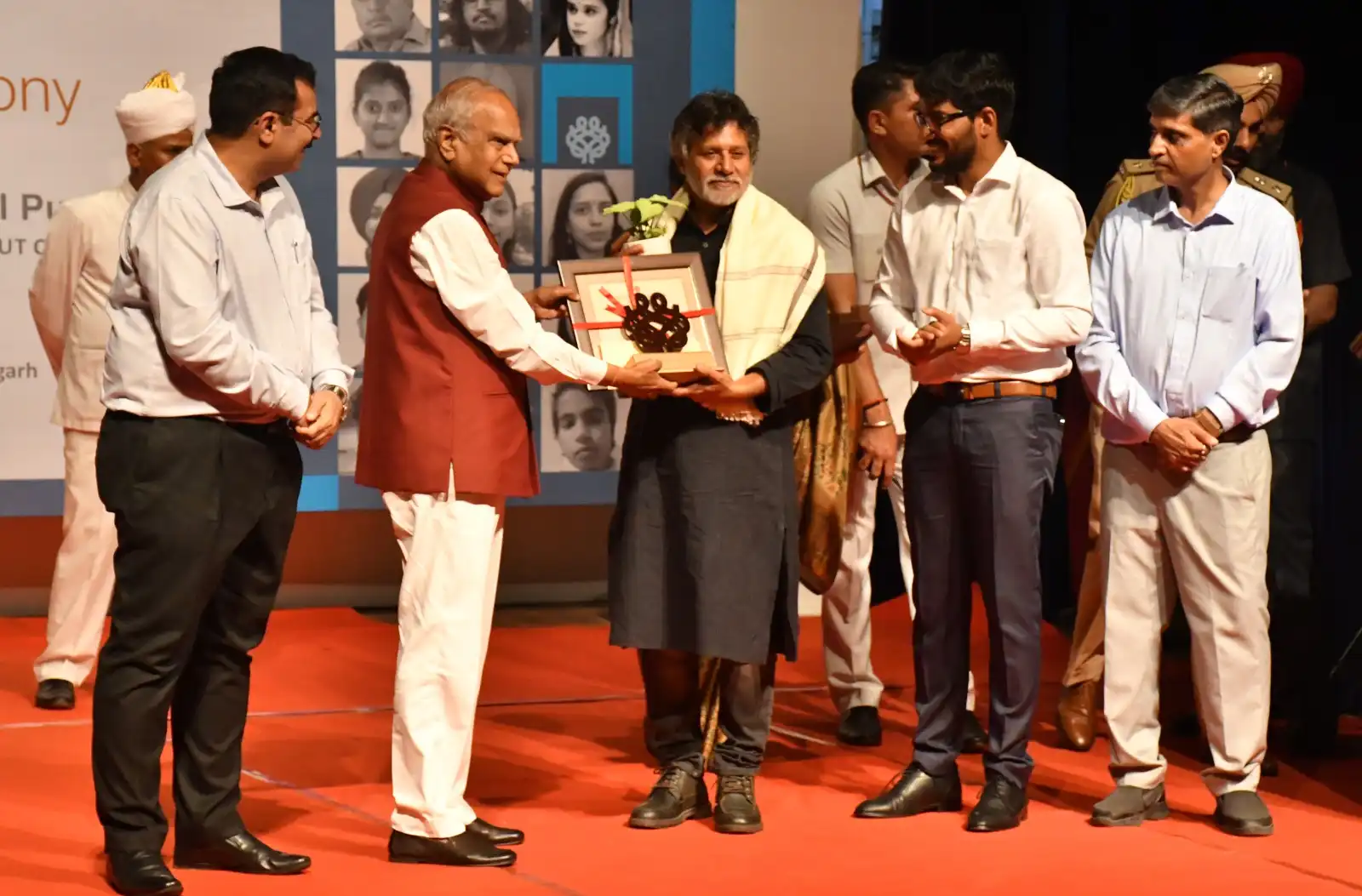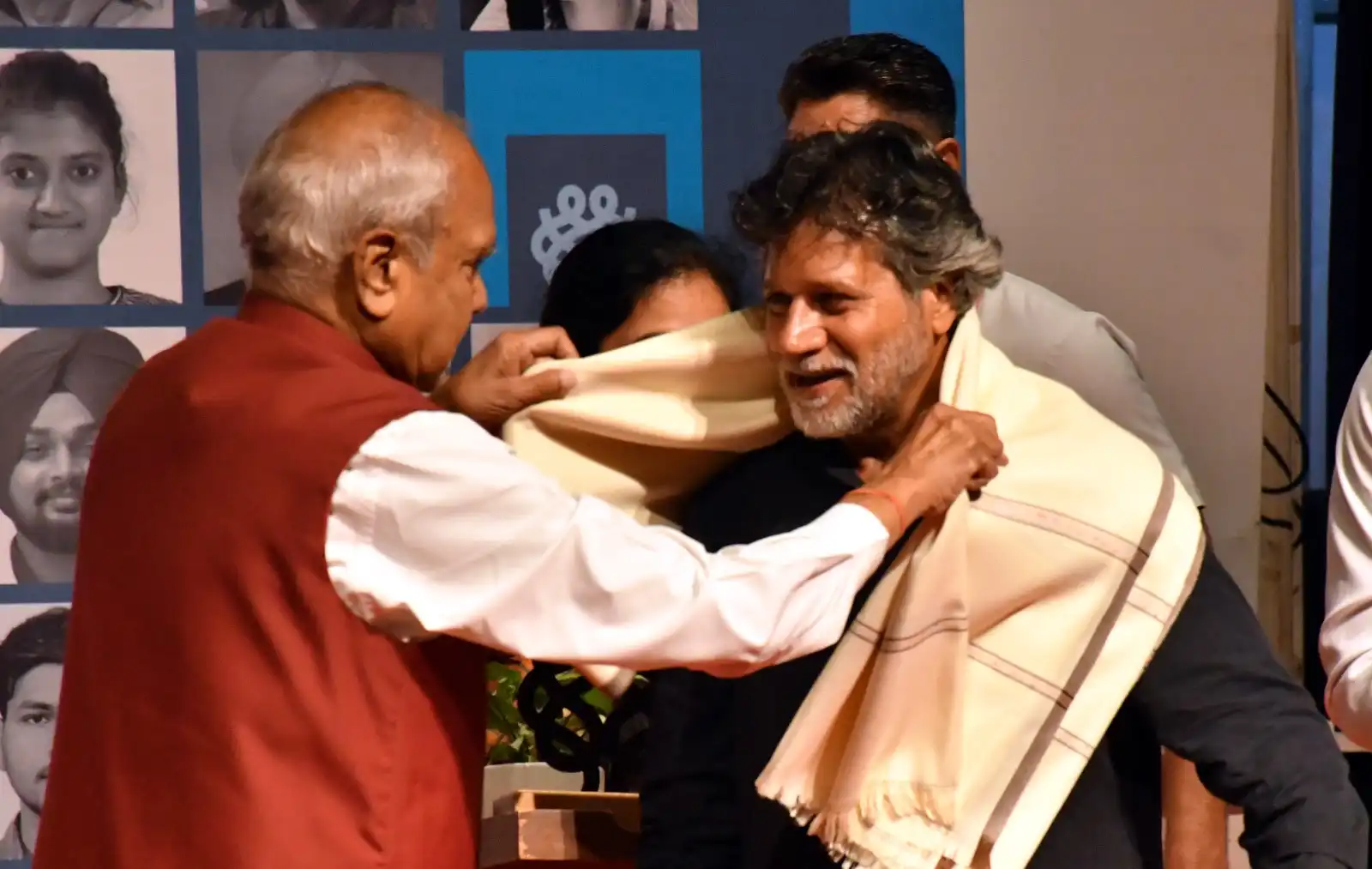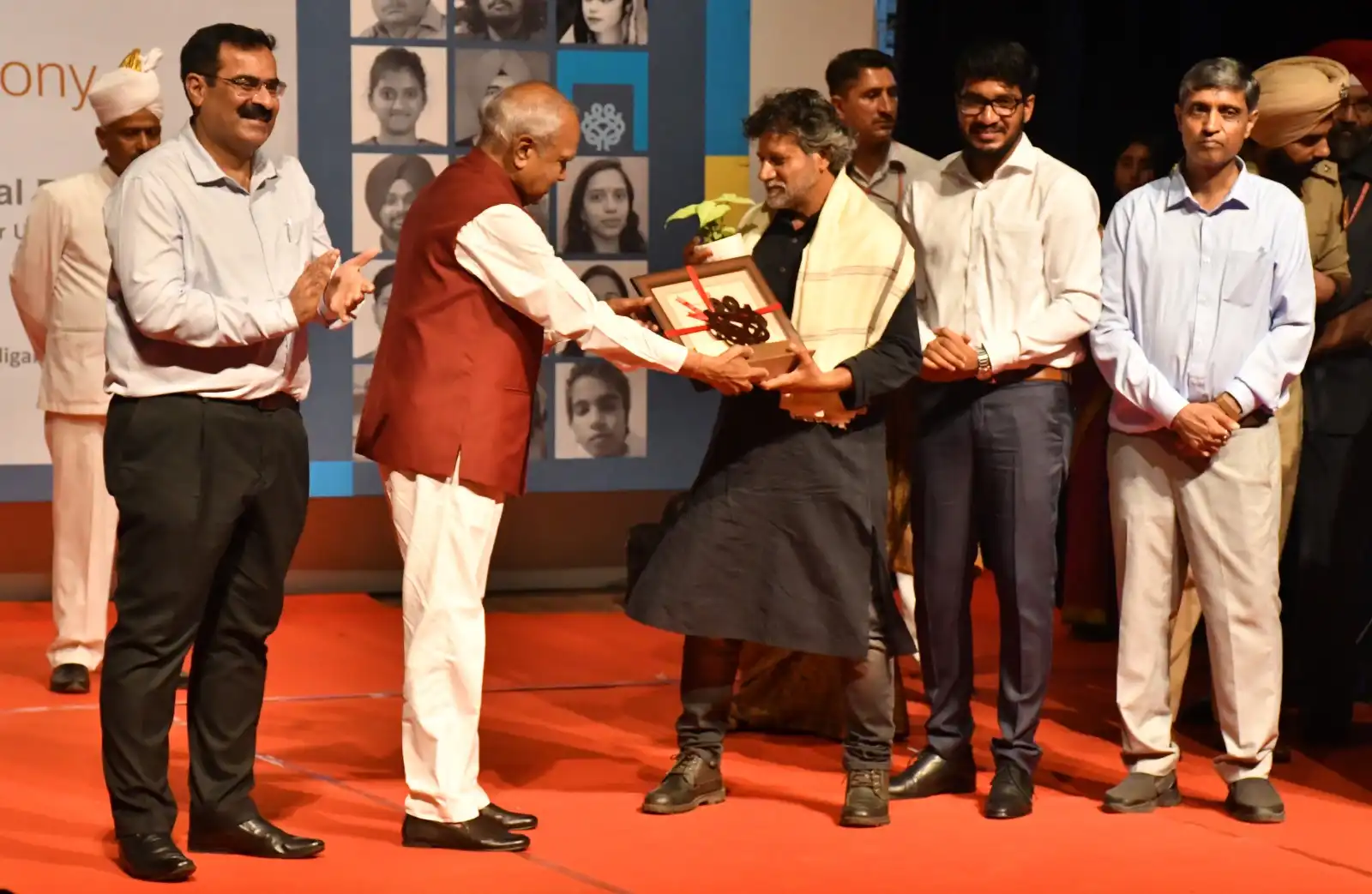News and Media
Article by Nonika Singh
Curiosity might have killed the cat, but the ever eager and forever curious Madan Lal believes it’s important to ponder and wonder. When Goldie Hawn said, “Curiosity, I think, is a really important aspect of staying young or youthful” she perhaps forgot to add artistic. In a perpetual state of awe, struck by life’s immeasurable beauty, Chandigarh based Madan celebrates life in as many myriad hues. Of course, the celebration isn’t surface deep or superficial. Its joy in pure form, anand as our scriptures inform and one that finds inspiration in Sufi thought. Like the swirling dervishes his works create their own rhythm and melody lost in its own musicality. Poetry in motion, resonant and vibrant these follow the Gurbani’s deep philosophical thought mann tu jot saroop hai, apna mool pehchan ( O my mind, you are embodiment of the divine light recognize your own origin ).
Though he is not pompous enough to delude himself that he has found his true self yet what he wanted to be was revealed in his childhood years. As a student of class six growing up in Talwandi Bhai he knew art was his muse. Whether he would end up in the Government College of Art Chandigarh one day, this lad from rural Punjab had no clue. Five years of training in art did not change or transform the innate artist in him. In fact, since he was a student of applied art and not painting various schools and isms of the west didn’t impact him greatly. His own cultural roots, the miniature tradition, the frescoes of Ajanta and Ellora, however, have consistently defined his imagery. Till date in the mudras of his figures you can sense the deeply imbibed influence of the Indian tradition. Sufism that also defines his poetry makes a strong presence on his canvasses too. The central figure in many of his paintings with head bowed in submission is almost like a Sufi figure. Buddha appears in many of his series… for which Indian artist can escape the influence of his mantra of eternal bliss?
Madan’s anthropomorphic images— part human part animal–are employed deftly to paint the emotional-scape of human beings and the complexity of man woman relationships. Eroticism too is a recurring thread. He doesn’t view erotica and spirituality as two disparate ends of the spectrum as both demand complete submission and immersion. Art and aesthetics too go hand in hand for him. Whatever may be the subject, he paints beauty… period. While elements of nature such as birds, peacocks, clouds, trees are bound to be beauteous, in his hands, dustbins become rose plants, road maps a lyrical figure. Why he lends sensuality even to a urinal. Besides, when he uses animal form… it’s not with negative thought or connotation. It’s not animal instinct that he is alluding to but animal power, drive and energy. Negativity has no place in his art even when he is reflecting upon profound issues. Like a true blue Punjabi he finds joie de vivre in everything he sees and touches. The world anyway is swarming with ugliness…. why add to it? So he believes and practices. For someone who paints in wee hours of morning expectedly painting is an act of prayer, meditation and riyaaz. When the world stands still something within him stirs and finds form that is at once evocative and poetic, alluring and awe-inspiring. Replete with metaphors which are like alphabets of the visual language his works are always redolent with meaning. If he were to just paint two figures the outcome he believes would be downright insipid. Unless figurative forms are correlated with metaphors, the work will have no resonance.
Rang udde han bina khamab de, rang bolde han bina shabdan de.”(Colours fly without wings and speak without words). If his colour palette seduces the viewer, technique that involves days of labour completes the process of entrapment. He might have been taken in by pahari school of painting, flatness of surface never ever fascinated him.
The methodology he has arrived at is very much his own. He moved away from time consuming medium of oils to acrylics for it suits his temperament and his technique. Step by step he applies one layer of colour, draws a little then adds another layer and the process goes on and on till he knows the dialogue with his canvass is over.
Of course, the communion that he strikes has its genesis in the craft of drawing. He draws like a man possessed and has an unending collection of drawings which form the blueprint of his creativity. Drawing from the reservoir of Sufi flavour that he could smell in his village Talwandi Bhai in Ferozepur district, barely 35 km away from Kasur, the land of mystic poet Bulle Shah he immersed deep in poetic musings at an early age. By the time he came to Chandigarh he had not only read Bulle Shah, Shah Hussein, Baba Farid but also Shiv Kumar Batalvi. Somewhere along the poet within was also born. But be it the poet or the painter, it’s the journey of self-realisation.
Roop rang aakar se nirakar tak, rachna se rachnakaar tak …. Apne se aap tak…( From form colour and shape to the formless, from creation to the creator from I to the self ) life is looking within an inward journey. Any wonder the little boy in him who would gaze ceaselessly at the vast expanse of fields and the endless horizon is very much alive and kicking off the ennui that envelopes most ordinary mortals. As wonderstruck and enamoured, the child within ensures that the artistic vision never turns stale or monotonous. So his vocabulary is forever seasoned with freshness and is continually changing. Much of what he experienced in his formative years has informed his artistic sensibilities. For instance writing on takhti in school days has transformed into calligraphy.
Living in Chandigarh for over three decades too has rubbed on his artistic process. Preoccupation with geometric forms for instance is most certainly a fall out of living in Le Corbusier’s well planned city. Urban living lends itself to Urban Emotions in which he introduced urban images like lock and key and symbols of calculations hinting at growing materialism. Most of his images go beyond the obvious. Lock and key, also analogous of sexual intimacy, is meant to open doors to deeper recesses. Keyhole peep into the life of man and woman tells you more about urban living than sociological essays can. Urban Phulkari, his more crowded series is his way of amalgamating two different worlds. Rural and urban coexist and stitch together memories of urban life just as his mother would piece different motifs while embroidering Phulkari.
But just when his Phulkari became too dense and populated with far too many motifs, he broke out of the mould. Now figures appear more fleshed out and realistic. Full cycle… but he began his artistic journey with abstraction. Five elements of nature were his muse for a long, long time. From realism to abstraction, Madan has been going back and forth. Over time actually since 2005 figures became his constant artistic companion leading him to express fully and more evocatively. As he crosses seven seas and participates in workshops across continents in places as diverse as Turkey and Macedonia he is enthralled with how visual idiom connects beyond cultural divide. Vice-Chairperson of the Chandigarh Lalit Kala Akademy, he likes forging the bond between art lovers and artists. Working with Handicrafts & Textile with Punjab Government, Chandigarh has also cemented his connect with the world of art.
Tera Pinjara Jangaal Ney Khana , Mian Mithu Urh Jana. (Your cage will be eaten by rust Mian Mithu( the parrot ) will fly away ). Deeply aware of the ephemeral nature of human life – body like the cage will rust and only the soul would remain– though he has found a ready and steady market that includes buyers like Tina Ambani, it’s spiritual quest that he is ultimately seeking.
Anhad naad… the sound of the cosmos and of human consciousness is where his search is directed and finds a resounding reflection in his canvasses. At the heart of his creativity is nostalgia, memory, mythology, roots, past and of course the ability to make it all possible and relevant to the present. As– Doug Ivester said; “Never let your memories be greater than your dreams,” he dreams with mind’s eyes and imbues a dream-like allegory to his paintings.
Article by Johnny M L
Madan Lal’s paintings human beings and their immediate surroundings transform into incarnated beings and new locations in order to exemplify certain truths that lie beneath the layers of quotidian occurrences in our daily lives. Predominantly these newly created worlds are infested with couples, mutually appreciating and adoring and at the same time engaged in a kind of competition with a lot of erotic potential that would end up in reconciliation, silence and bliss. However, Madan Lal ironically calls them as ‘urban emotions’. For the artist, urban emotions are the emotions of the people who are caught in the urban snare called contemporary life. These emotions are explosive, alluring and at the same time vying for supremacy over reason; people in urban locations want to be always the victors, they just don’t want to witness failure in life though that is one of the dominant characteristics of urban life.
Urban emotions, in Madan Lal’s parlance, come to us as a set of metaphors to be read out and enjoyed within the given context of lyrical expressionism. These metaphors are created out of human couples and their bodies become the fields to accommodate all their dreams, desires and hopes. These entities that make human life rich and colorful do not often get a chance for their full blooming in urban situations. Hence, everything has to happen in a realm of fantasy and art is one way that people have found to play out their fantasies, dreams, desires and hopes. Madan Lal recognizes this fact and his works become the reservoirs of these sublime human emotions. However, Madan Lal is not just a romantic who would always portray life as something filled with fantasies and colorful desires.
In these paintings, human contradictions and contestations are also played out well by creating the metaphors which are capable enough to carry the power of the dark feelings. As I mentioned before, though the transcendence of these darker feelings through the medium of art is one way of making life livable, it is pertinent to see the reality as it is. The starker forms of life have to be dealt with in the medium of art by creating adequate metaphors. Here in Madan Lal’s works one could see how he understands this predicament before any artist and handles it by creating composite images of human beings and animal forms.
Seen from the art historical point of view, creating anthropomorphic images in order to express inner human emotions is an artistic ploy, reaching up to certain levels of allegorical narratives. The anthropomorphic forms that we see in Madan Lal’s works, however do not narrate any particular story, instead they deal with the human conditions as a universally shared and understood one, where both the sublime and darker forces work at once within the minds of the human beings causing both creation and destruction. Hence, when a woman gets transformed into a bull or a man achieves the form of a bird or fish in the paintings of Madan Lal we come to understand how he universalizes these entities into palpable and recognizable artistic forms. These transformations are universal in the sense that they have been already there in the collective unconscious of the people all over the world and identifying with these images or empathizing with them become easier irrespective of geographical locations.
One of the images/metaphors that Madan Lal very skillfully uses is that of a lock and key. This too being a universal symbol of sexual intimacy, gender polarity, physical anatomy of the male and female, Madan Lal uses it to maximum effect by creating a multitude of images. The lock is not just about the female sexuality but it also stands for the secrets of what lies beyond the surface of human life. The potential openers, the keys are with the onlookers and the artist. There is a sort of male principle and male outlook getting predominance in these works. However, we should take it as an artistic license than a very conscious gender political positioning. And at the same time we cannot forget the fact that the artist is a male and his psychological as well as aesthetical conditioning would in a way get reflected in his works.
Madan Lal worships nature up to certain extent. His adoration however is not about the glories that are lost by the nature. He does not lament either on the losses incurred by the human interventions. Like a true romantic does, this artist also looks at nature as a pristine ‘giver’ who has to be worshipped and adored. Though he does not use too many shades of green to emphasis the physical beauty of nature, his love for the colors like blue and red tells us how the artist employs them to underline the power of nature in varying contexts and locations. These paintings celebrate the ultimate human bonding called love. And the artist is all the more obliging to reveal the depths of his creative thoughts in a multitude of images and metaphors.
Article by Aruna Bhowmick
The Indian view of the identity of personality and conduct with teaching is well rendered in the apt comment of a Hindu friend of Heinrich Zimmer in criticism of a certain popular book on Oriental philosophy. “Real attainment is only what finds confirmation in one’s own life. The worth of a man’s writing depends on the degree to which his life is itself an example of his teaching.” This is very true of the works of Madanlal the artist and the man. Characterised by smooth rounded voluminous forms, textured within by gentle etchings, each one a universe in itself, and soft tones doctored by minimal lines, have long been the recognisable features of Madanlal’s works.
There is a transparency in his colours to suggest the transient nature of the physical, as believed in Hindu philosophy, wherein the body or form, is fleeting, the life force passing from one to another in birth and rebirth. The bent head makes humble the persona, underlining the spirit contained within. The physical presence could be that of a monk, a peasant, or even a king of abdicated throne. But above all probably it is the common man, meek and docile.
Made consciously flexible and Indian, there is a universe implanted within each of his forms, layered and textured, replete with life. Marked with architectural registers of civilisation, impressions of ancient scripts, fish, suggesting the beginning of life, the kite to voyage the flights of freedom, or simply seed, grain and textures of love — his compositions are poetic with an effortless ease that makes them truly representative of the artist. In spirit the works are all embracing, formally aligning all life forms—human, animal or plant, dovetailing them into one another, the cow discernible in the some of the four-legged forms, probably in veneration of its benevolent motherhood.
In reality, Madanlal is as much a poet of words as of palette, line and colour, and perhaps even a philosopher in his personal capacity of artistic creativity. He talks with great fascination of the poetic stalwarts of the Punjab, now as much a part of folklore as of Punjabi Literature, and inspiration derived from them. Windows to his inner world, Madanlal’s paintings portray “ego less forms”, people supple in humility, complementing the lyric and volume of their frame. This volume also invests them with a discernibly sculptural character, deriving from ancient India, pegging it deep into tradition.
Philosophic wisdom in the east is considered a specialised learning directed to the attainment of a higher state of being and thus quite above general information. At another level though, it is also quite simple, its foundations laid on the basic principles of detachment, discipline and self-control. Pursued even in moderate degree, these can make a philosopher of man, more so if he is creative. This is true of Madanlal. Content in his personal space of quiet living and rooted lifestyle, his works convince even more after meeting him in person. It is difficult indeed to count the components of his oeuvre because they encompass the cosmos in their depth and reach, exuding a fecundity that is manifest more as a potent cosmic continuum, rather than any evocation of sensuality. It throbs with a life force that permeates the world, effecting a fruition that is continuous and pervasive, both music and prayer at the same time. Indian philosophy also proposes the human soul as one with Brahma, the vital force. The diffused boundaries in Madamlal’s frames tend to reaffirm this merger, his colours fusing into each other as the life force with its source, each frame a universe by itself.
The slightly undefined quality of his protagonists renders them remote and mysterious, sans the rigidity of modern times, gnarled and knotted with desire and ambition, driven by material hunger. Somewhere deep down in the artist’s consciousness is discernable a yearning for the past. Modernity today is a special situation arisen under the impact of industrial and electronic revolutions, unleashing fatal forces. The wheel in one of the works here denotes just this, painted in greasy black machine tool colour, dark and menacing in its presence. The upper half of the work conveys tranquillity, portrayed in hues of blue, grey and mauve. Modernity is also depicted via recurring images of the bicycle in different situations. Undeterred though, the spirit overcomes times to soar free, maintaining clarity. This is represented in the inclusion of the dove or the kite.
Madanlal is freshly returned from his show in England as we sit talking. A sudden spurt of April rains begin to beat down the roof punctuating the afternoon making me sigh with relief as the dust settles down. Madan worries over the untimely pour. “The crops will spoil,” he rues, revealing an earnest concern and connectivity to his soil. “We are after all sons of the soil—farmers at heart. Crops will always remain central to our thoughts.” I am touched and full of admiration. So it is that among the myriad elements of his compositions, we discern neat little rows of cultivation dotting the frame – reminders of our neglected subsistence.
Rituals in the East are serious business. They would otherwise not survive to get carried through generations and cultures. Likewise for some, living life as per one’s own calling is like a ritual, to be practiced and nurtured to fulfil one’s commitments to self, and the world. Seeds falling from open palms form inevitable threads of continuity. Leaves drop, a kernel opens to reveal new life, almost making a ritual of the very process of living, nurturing roots within the peace of a contented existence. Consistency and faith in one’s being, over time makes ritual of a lifestyle. Carried with belief it becomes, as it should, a religion—personal, and true to Hindu philosophy, a way of life, unlike many other religions of the world.
Not to be bypassed is Madanlal’s penchant for drawing as a precursor to painting, for therein lie his thought for each work, the scaffolding to support everything that is to built thereafter. In mindless times such as these people and artists like Madanlal are much need antidotes to our restless society.






